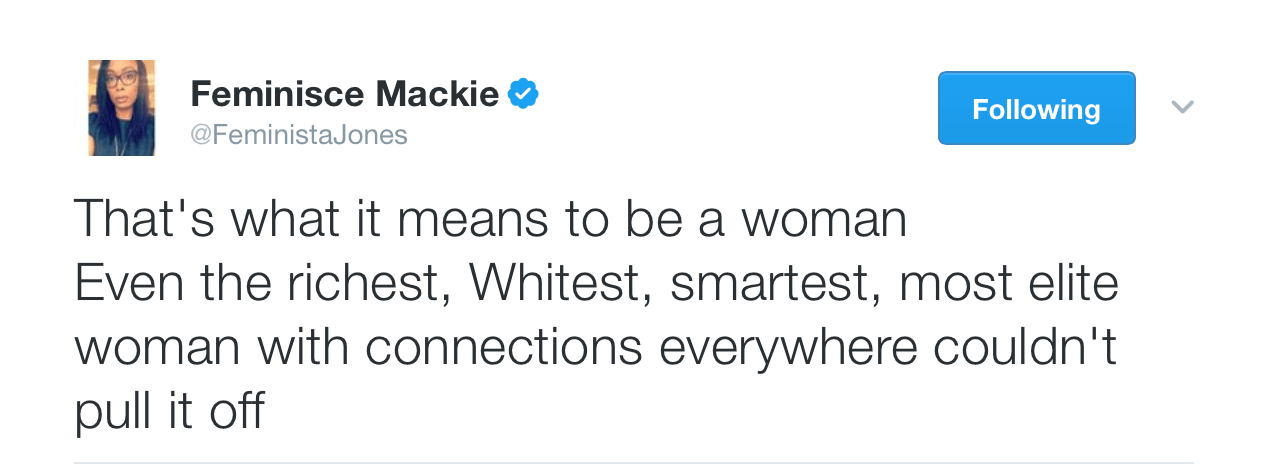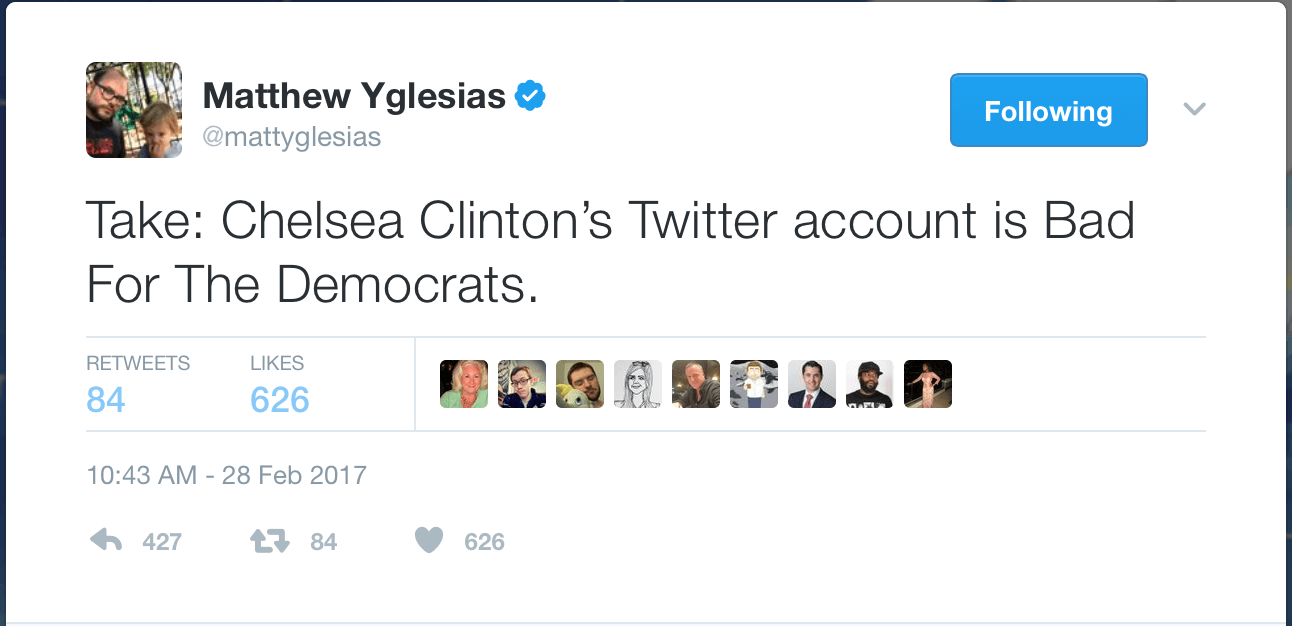

All the Rage
The Future Is Female—And Still Unrelentingly Misogynist
(White) male media dominance drove the 2016 election narrative, helping to elect a dangerously incompetent POTUS over Hillary Clinton – and it continues to denigrate the powerful women following in her footsteps.
This article was made possible because of the generous support of DAME members. We urgently need your help to keep publishing. Will you contribute just $5 a month to support our journalism?
It is not hyperbole to posit that society’s impossible standards for women played a significant role in leading us to the democratic crisis that the United States currently faces. In just a little over a month, President Donald Trump tried to issue an Islamophobic travel ban, saw National Security Adviser Michael Flynn resign in a record 24 days, and may also have to fire Attorney General Jeff Sessions over Russia ties and lies. And that’s just the tip of the iceberg.
A bigoted, incompetent, and wholly inexperienced person has no business being our Commander-in-Chief, let alone defeating one of the most qualified people (a woman) to ever run for the job. And yet, this story is all too cliche and familiar for working women, who very much recognize that societal tendency to reward less-credentialed men.
As the New York Times’ Nick Kristof wrote in September 2016, when the public holds Trump to higher regard than Hillary Clinton, “something has gone wrong.”
Ironically, Kristof himself is very much a part of that problem. He represents a glaring issue that hampers the news media from properly representing perspectives across demographic groups: the fact that white men comprise between 65% and 90% of hard news positions, depending on the format. And when you mix white male dominance in our Fourth Estate with a white nationalist running for president, it’s no surprise that the result was deeply broken coverage that did not adequately communicate the stakes of this election. For instance, researcher Zeynep Tufekci analyzed articles across the Washington Post, New York Times, and Politico, and found that five times as many stories were written about Clinton’s emails than Trump’s conflicts of interest.
The gender biases that permeated throughout these media narratives gave way to a false equivalency between Clinton’s and Trump’s shortcomings. Despite Trump openly stoking racism, winking to Russia, and refusing to disentangle himself from his business conflicts, it was Clinton who was presented as the deeply “flawed” candidate. In January, I wrote about that loaded word and how it was wielded like a weapon against Clinton during the campaign and even in defeat:
“Flawed,” when attached to Clinton, didn’t take on the connotation of “We all make mistakes and that’s okay.” That’s reserved for men. Instead, it became an insidious reminder of the perfection that the world expects from women. This impossible standard is a trap because when we inevitably fall short of meeting it, society tells us that we only have ourselves to blame: “If only you were more of this or less of that, then you would have succeeded.”
And because Clinton wasn’t allowed to be both complex and beloved — a privilege her (white) male peers enjoy—there was little room for nuance in debates over her strengths and weaknesses. On this front, Rebecca Traister lamented:
The real bitch is when I hear [Clinton] attacked by men who claim to be feminists but actually despise her with inexplicable intensity … It makes me spittingly angry. It transforms me into a knee-jerk defender of a candidate about whom I actually feel very torn…but damn if another round of sniping from liberal white boys isn’t going to radicalize me in her defense all over again.
To this point, Melissa McEwan added, “There is no more damning evidence of the unfathomable scope of misogyny to which Hillary Clinton is subjected than the fact that the U.S. media’s favorite game is trying to destroy her.” And we’re seeing these old habits of using Clinton as a punching bag die even harder four months AFTER the election. While some men have lamented that Clinton has not been active enough in the resistance movement, others like Business Insider senior editor Josh Barro and Vox writer Matt Yglesias have knocked her for simply speaking out at all (weird how folks didn’t try to silence Al Gore, John Kerry, Mitt Romney, or John McCain after their election losses). This “damned if you do, damned if you don’t” dynamic is not only a lesson in Double Standards 101, but indicative of the very sexism—both blatant and insidious—that is deeply layered into every fabric of society.
As Sady Doyle so astutely pointed out, the populace at large really loves Clinton when she is in or out of office, but not when she is seeking the powerful position itself. Indeed, when Clinton stepped down from the Obama administration in 2013, she enjoyed the second-highest approval ratings (69%) of any Secretary of State since 1948. Doyle even predicted that if Clinton lost the general election: “She’ll have run out of rungs to climb. The loss would let us forgive her.” In a way, this rings true, as evidenced by the plethora of puff pieces about standing ovations at Broadway shows or selfies with supporters while she hikes in the Chappaqua woods.
And yet, as we have seen from problematic men before, a reflexive desire to tear down Clinton is as omnipresent as ever. But why does the Clinton hatred persist even after she poses no threat to (white) male political dominance? For one, it appears as though male media members like Barro and Yglesias do not know how to cope in a world where they can no longer use Clinton as a foil. As Jill Filipovic writes in Cosmopolitan, men to the left of center know better than to be outright misogynistic—when Clinton was running for president, they used unevenly directed policy concerns as a veil for their vague anxieties around politically ascendant women. But in a post-November 8 world, biased men can no longer hide behind these fronts (since Clinton is now a private citizen), and yet, they can’t seem to stop themselves from falling back into their old ways.
The second factor that gnaws at patriarchal power is the fact that Clinton won the popular vote by close to 3 million. If she had lost by every measure imaginable, then narratives could crystallize around Clinton as a wholly sympathetic figure. In turn, these same problematic men could pat themselves on the back and say, “See, I was right — Democratic Party voters shouldn’t have nominated this woman.” But the very mythical notion of the “exceptional woman” is a farce, as Doyle explains in Elle:
Patriarchy has always had room for the Exceptional Woman—the one woman smart enough, sweet enough, strong enough, soft enough, pure enough, sexy enough to satisfy all of our culture’s contradictory demands on women, and thus make it to the top of a sexist system on merit alone. Patriarchy needs that woman. She provides men with an excuse to blame women for their own pain and struggles while simultaneously assuring women that sexism only needs to be outwitted to be overcome. She tells us that the system is survivable for women—you simply have to be the right kind of woman.
And the messy truth of the matter is that while Clinton did not win by the rules of the game, she cracked the glass ceiling in a big way. Millions of voters across the country exhibited that the United States was indeed ready for a woman (THIS woman!) to hold the highest office of the land. And if our electoral system more adequately weighted the will of the people, Clinton would likely be president. But it kills the men, who are either consciously or subconsciously invested in (white) male dominance, to cop to her partial success in eroding old systems of power.
It is thus important to revisit the ways gender bias reared its ugly head throughout the campaign—and into its aftermath—because similar patterns are re-emerging around women whose political stars are on the rise. Take Elizabeth Warren, for example. In Clinton’s tête-à-tête with Bernie Sanders, leftist men often employed Warren as a shield to try to duck from charges of sexism. But just like clockwork, the same mud that men threw Clinton’s way is now being diverted to Warren. On the re-purposing of this misogynistic playbook, Filipovic remarks:
Now [Warren’s] a woman who may actually be seeking power against a man, not a theoretical interloper against another woman … And as they did with the decades-long trashing of Hillary Clinton, some men on the left (and some women too) are now happy to walk down on the trail forged by the blatantly sexist far right.
Hillary Clinton’s daughter, Chelsea, has also been on the receiving end of similarly sexist criticisms. Chelsea has emerged on Twitter as a fierce voice of the growing resistance, and predictably, as soon as there were whispers she may run for office, a chorus of men started telling her to sit down and be quiet.
On the hopeful end of things, an unprecedented number of women are signalling that they will run for office, giving Americans (including the 53% of white women who voted for Trump) ample opportunities to learn from the gendered mistakes made during the 2016 election. With staggeringly low female representation in government — women only comprise 19% of Congress, 25% of state legislatures, and 12% of governorships — it would be wrongheaded to reproduce the oppressive narratives that keep these numbers stagnant. From Cosmopolitan:
It’s crucial to be out front on this, pushing back on this subtle misogyny that elevates men while simultaneously raising the bar impossibly high for women in politics. There are no perfect politicians. But in large part because of quiet, hard-to-pin-down misogyny on the left and the right, there are far too few female ones.
And I, for one, am bullish about a future that is much more female.
Before you go, we hope you’ll consider supporting DAME’s journalism.
Today, just tiny number of corporations and billionaire owners are in control the news we watch and read. That influence shapes our culture and our understanding of the world. But at DAME, we serve as a counterbalance by doing things differently. We’re reader funded, which means our only agenda is to serve our readers. No both sides, no false equivalencies, no billionaire interests. Just our mission to publish the information and reporting that help you navigate the most complex issues we face.
But to keep publishing, stay independent and paywall free for all, we urgently need more support. During our Spring Membership drive, we hope you’ll join the community helping to build a more equitable media landscape with a monthly membership of just $5.00 per month or one-time gift in any amount.























































































